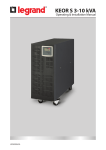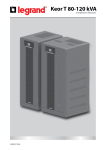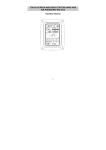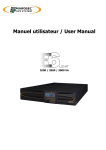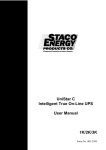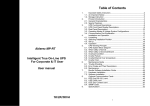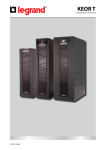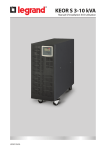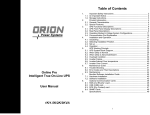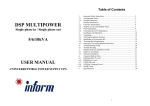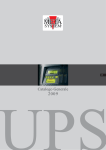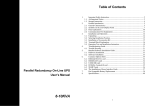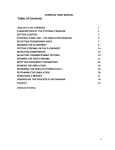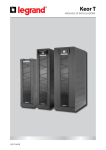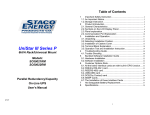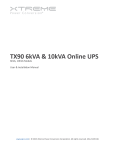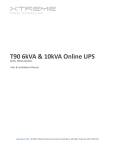Download KEOR S 3-10 kVA
Transcript
KEOR S 3-10 kVA Operating & Installation Manual LE08008AB KEOR S 3-10 kVA EN 2 ENGLISH 5-6 Operating & Installation Manual KEOR S 3-10 kVA Important Notices! Thank you for choosing LEGRAND UPS System to supply your Critical Application. This manual contains important information about commissioning, usage and technical properties of the UPS. It also contains safety information for operator and instructions to secure your critical load. Applying the recommendation detailed in this manual is necessary to use UPS safely and correctly. Keep this manual near UPS for easy consultation! Reproduction, adaptation, or translation of this manual is prohibited without prior written permission of LEGRAND Company, except as allowed under the copyright laws. Read the manual completely before working on this equipment! The manufacturer reserves the rights to change the technical specifications and design without notice. LEGRAND reserves the rights to change the information in this document without notice. Refer to http://ups.legrand.com/ web site to dowload last release and translations Units that are labelled with a CE mark comply with the Standard: EN 62040-1 and EN 62040-2. 3 Description of the Symbols Used in the Manual This symbol points out the instructions which are especially important. This symbol points out the risk of electric shock if the following instruction is not followed. This symbol points out the instructions, which may be resulted with the injury of the operator or damage of the equipment if not followed. All packing material must be recycled in compliance with the laws in force in the country where the system is installed. Description of the Abbreviations Used in the Guide UPS: Uninterruptible Power Systems ESD: Emergency Switching Device RS232: Serial Communication Protocol RS485: Serial Communication Protocol MODBUS: Modicon Communication Protocol SNMP: Simple Network Management Protocol V: Volt A: Ampere P: Power For Mains Supply, Auxiliary Mains Supply, Output, Battery Circuit Breaker and Maintenance Bypass Circuit Breaker; “ON”: Closing the Circuit “OFF”: Opening the Circuit 4 Operating & Installation Manual KEOR S 3-10 kVA Index 1 Foreword 1.1. Overview 1.2 Manual 2 Warranty 2.1. Terms of Warranty 2.2 Out of Warranty Terms and Conditions 7 7 7 8 8 8 3 Safety 9 3.1 3.2 3.3 3.4 3.5 9 9 10 11 11 Description of the Symbols Used on the Labels Applied to the UPS Individual Protective Gear Important Notice for UPS Important Notice for Battery Emergency interventions 4 Requirement 4.1 Transportation 4.2 Placement 4.3 Storage 4.4 Electrical Requisites 5 Installation 5.1 Models and Dimensions 5.2 Unpacking Procedure 5.3 Installation Procedures and Instructions for Single Systems 5.4. Installation Procedures and Instructions for Parallel Systems (for 6-10kVA) 5.4.1. Important Safety Instructions 5.4.2. Parallel System Accessories and Installation Position 5.4.3. Installation Instruction 5.4.4.Parallel Setting 5.4.5. Start-up Operation Procedure 6 Communication 6.1. Serial Communication (RS232) 6.2. SNMP/WEB Card 12 12 12 13 13 14 14 15 16 23 23 23 25 26 26 32 32 33 5 7 Operation Modes 7.1. 7.2. 7.3. 7.4. 7.5. 7.6. Online Mode (norl) Eco Mode (Eco) Bypass Mode Battery Mode Frequency Converter Operation (cF50 – cF60) Maintenance Bypass Mode (for 6-10kVA) 8 Front Panel & Rear Panel 8.1. Front Panel Segments 8.1.1. Keypad 8.1.2. Liquid Crystal Display (LCD) 8.2. Rear Panel 9. Operating Procedures 9.1. UPS Default Data and Special Function Execution 9.2. UPS Default Settings and Their Alternatives 9.3 Commissioning 9.3.1. Start-Up with the Mains 9.3.2. Start-Up with the Battery (Cold Start) 9.4. Decommissioning 9.5. Maintenance Bypass Commissioning and Decommissioning Instructions (6-10kVA) 9.6. Emergency Switching Device (ESD) 10 Preventive Maintenance 35 35 36 37 37 38 39 39 39 41 44 46 46 49 51 51 53 54 54 55 56 10.1. Batterie 10.2. Fan 10.3. Capacitors 56 56 56 11 Troubleshooting 60 Appendix-1: Error List Appendix-2: Status & Alarm Buzzer Appendix-3: Technical Specifications Appendix-4: Description of UPS and Block Diagram 6 34 60 61 62 63 Operating & Installation Manual KEOR S 3-10 kVA 1. Foreword 1.1. Overview Thank you for choosing LEGRAND UPS Keor S product. KEOR S has been designed with advanced technologies and the latest compo¬nents generation; realized to satisfy both users and instal¬lers in their operational needs of high availability and perfor¬mance. This UPS aims to be efficient, functional, safe and very easy to install and use. LEGRAND has studied the best way to reconcile high-tech performance and ease of use, making “user friendly” technologi¬cally advanced products. This product is manufactured in an ISO 9001 & ISO14001 certified factory in full compliance with the eco-design laws. The UPS Keor S system is made in compliance with the existing European Community directives and with the technical standards in force to comply with CE marking as certified by the Declaration of Conformity issued by the Manufacturer. 1.2. Manual • The purpose of this manual is to provide indications for using the equipment safely and to carry out first level of troubleshooting. • This manual is addressed to persons already educated on precautions to adopt in face of electrical hazard • This manual is addressed to “User“, generic term to identify all persons that will have the need and / or obligation to provide instructions or operate directly this UPS equipment. •Adjustments, preventive and curative maintenance jobs are not dealt with in this manual as they are reserved exclusively to skilled and authorized Legrand UPS Technical Service Engineers. • The intended use and configurations envisaged for the equipment are the only ones allowed by the Manufacturer; do not attempt to use the equipment in disagreement with the indications given. Any other use or configuration must be agreed and written by the Manufacturer, in such a case, will be an enclosure to the manual. •For its use the user must also comply with the specific laws in force that exist in the country where the equipment is installed. Reference is also made in this manual to laws, directives, etc., that the user must know and consult in order to fulfil the purposes established by the manual. •If information is exchanged with the Manufacturer or assistance personnel authorized by the former, please refer to the equipment’s rating plate data and serial number. • The manual must be kept for the equipment’s useful life cycle and, if necessary (e.g. damage which prevents it being consulted even partially) the user must ask the Manufacturer for a new copy, quoting the publishing code on the cover. • The manual reflects the state of the art at the moment the equipment was put on the market, of which it is an integral part. The publication complies with the directives in force at such a date. The manual cannot be considered inadequate if updates of standards or changes are made to the equipment. • Any integration to the manual which the Manufacturer deems fitting to send to the users must be kept with the manual, becoming an integral part of it. • The Manufacturer is available to its clientele to provide additional information and will take into consideration any suggestions made to improve this manual to bring it even closer to the requirements for which it was drawn up. • If the equipment is sold, which always includes handing over this operating manual, the primary user must notify the Manufacturer, giving him the address of the new user so the latter can be reached if there are any communications and/or updates deemed indispensable. 7 2. Warranty 2.1. Terms of Warranty • Warranty period begins from the date of commissioning of the UPS by authorized LEGRAND UPS Technical Service staff or authorized LEGRAND distributor Technical Service Staff. • The UPS including all the internal parts is under the warranty of LEGRAND. • If the UPS malfunctions because of component, manufacturing or installation (if it’s done by authorized LEGRAND UPS Technical Service Personnel) problems during the warranty period, the UPS will be repaired (spares and labour) by the Manufacturer under warranty. 2.2. Out of Warranty Terms and Conditions This Warranty does not apply if: • UPS not commissioned or maintained by an authorized LEGRAND UPS Technical Service staff or an authorized LEGRAND distributor Technical Service staff. • UPS not used according the terms of operating and installation manual • Product serial number label has been removed or lost This Warranty does not cover any defects or damages caused by: • Neglect, accident, misuse, misapplication • Failure due to fortuitous circumstances or force majeure (lightning, floods…etc.), • Unloading and transportation damage and failures after delivery, • Damage or injuries caused by negligence, lack of inspection or maintenance, or improper use of the products, • Faulty electrical wiring, • Defects arising either from designs or parts imposed or supplied by the purchaser, • Defects and damage by fire and lightning, • Failures due to modification in the products without LEGRAND approval, • Improper installation, testing, operation, maintenance, repair, alteration, adjustment, or modification of any kind by unauthorized personnel, The Manufacturer will repair the device in such cases for a fee and is not responsible for the shipment of the equipment. The Battery warranty does not apply if the temperature in the room exceeds 25 °C. Extended battery warranty does not apply if: • UPS has not been commissioned • A yearly preventive maintenance visit has not been performed By an authorized LEGRAND UPS Technical Service staff or authorized LEGRAND distributor Technical Service staff. The UPS may contain batteries that should be recharged 24Hours min after 6 month storage duration to avoid deep battery discharge. Warranty cannot apply on batteries that have suffered of deep discharge. 8 Operating & Installation Manual KEOR S 3-10 kVA 3. Safety Information related to safety of the UPS, battery, load and the user is summarized below. But the equipment should not be installed before reading the manual completely. 3.1. Description of the Symbols Used on the Labels Applied to the UPS PE: Protective Earth PB: Protective Bonding Danger! High Voltage (Black/Yellow) This symbol points out the instructions, which may result with injury of the operator or damage of the equipment if not obeyed. 3.2. Individual Protective Gear There is a high risk of electrical shock with the equipment as well as a considerable short circuit current. When installing and servicing the equipment it is absolutely forbidden to work without the protective gear mentioned in this paragraph. The personnel who are going to work with the equipment for installation or maintenance jobs must not wear clothes with baggy sleeves or laces, belts, bracelets or other metal items that could be a hazard source. 9 The following indications summarize the protective gear to wear. Accident and spark proof footwear with rubber sole and reinforced toe Use : always Waterproof rubber gloves Use : always Protective gear Use : always Protective glasses Use : always 10 3.3. Important Notice for UPS • The equipment may only be installed and commissioned by authorized LEGRAND UPS Technical Service Personnel. • This manual contains important instructions that you should follow during installation and maintenance of the UPS and batteries. Please read all instructions before installing the equipment and save this manual for future reference. • Not obeying the instructions written on this manual which may result with possible injury of the operator or damage of the equipment. • The equipment shall be packed properly during transportation and proper equipment should be used for transportation. Never transport in horizontal position. • The UPS must always stands in a vertical position. Make sure that the floor can support the weight of the system. • Connect the PE ground connector before connecting any other cable. • Because of “LITTLE LEAKAGE CURRENTS” generated by EMI Filter of the UPS, it is necessary to double ensure if the earth of the UPS is properly grounded before AC mains is connected with. • UPS is designed for indoor use. To reduce the risk of fire or electric shock, install this UPS in a temperature and humidity controlled indoor environment, free of conductive contaminants. Ambient temperature must not exceed 40°C (104°F). Do not operate near water or excessive humidity (95% maximum without condensation). • UPS requires 1Ph-N+PE input connection. • Neutral system: refer to Section 5.3.1.5 Output Connection. • Even when connections removed, residual voltages of capacitors and/or high temperature may exist on connection terminals and inside the UPS. Before working on terminals, check between all the terminals included PE that no hazardous voltages exist. • The connections shall be made with cables of appropriate cross-section in order to prevent the risk of fire. All cables shall be of insulated type and shall not be laid out on the walking path of the persons. • According to IEC 62040-2; this is a category C2 UPS product. In a residential environment, this product may cause radio interference, in which case the user may be required to take additional measures. • Contact your local recycling or hazardous waste center for information on proper disposal of the used battery or UPS. • Make sure that the UPS is not overloaded to provide a higher quality supply to the loads. • In case of an extraordinary situation (damaged body, cabinet or connections, penetration of foreign materials into the body or cabinet etc.) de-energize the UPS immediately and consult to the LEGRAND Technical Assistance Center. • When used for particular applications such as life support systems or any other application where product failure is likely to cause substantial harms to person, we would advise you to contact LEGRAND UPS to confirm the ability of these products to meet the requested level of safety, performance, reliability and compliance with applicable laws, regulations and specifications. 3.4. Important Notice for Battery • The batteries may only be installed and commissioned by authorized LEGRAND UPS Technical Service Personnel. • Make sure that the battery qty is proper for the unit and they are same type and capacity. Otherwise danger of explosion and fire is within the bounds of possibility. • Do not dispose of batteries in a fire. The batteries may explode. • Do not open or mutilate batteries. Released electrolyte is harmful to the skin and eyes. It may be toxic. • In case of electrolyte in contact with skin, immediately wash the contaminated skin with water. • Replaced batteries must be disposed of at authorized battery waste disposal centers. • A battery can present risk of electric shock and high short circuit currents. The following precautions should be observed when working on batteries; • Remove rings, watches, necklaces, bracelets and all metal objects. • Only use tools with insulated handles. • Wear rubbers gloves and a rubber apron when handling batteries. • Do not lay tools or metal parts on top of batteries. • Eye protection should be worn to prevent injury from accidental electrical arcs. • Before a maintenance or repair work on the UPS; • Switch the input and output circuit breakers (Q1 and Q2) to “OFF” position. • Switch battery circuit breakers (Q3) to “OFF” position. • If UPS has external batteries; switch the circuit breakers (F5) of the battery cabinet(s) to “OFF” position. • Determine if the battery is inadvertently grounded. If inadvertently grounded; remove source of ground. Contact with any part of a grounded battery can result in electrical shock. 3.5. Emergency interventions The following information is of a general nature. For specific interventions please consult the laws existing in the country where the equipment is installed. Operating & Installation Manual KEOR S 3-10 kVA First aid interventions If any first aid intervention is required, comply with company rules and traditional procedures. Fire-prevention measures Never use water to extinguish fire but only the extinguishers designed specifically for electronic equipment or battery fires. 11 4. Requirement 4.1. Transportation The UPS must be placed and stand in a vertical position throughout the transportation. Use suitable equipment to remove the UPS from the pallet. The equipment shall be packed properly during transportation. Therefore it is recommended to keep the original package for future need. All packing material must be recycled in compliance with the laws in force in the country where the system is installed. 4.2. Placement • UPS is not designed for outdoor application. • The equipment and the batteries should not be exposed to direct sunlight or placed near to a heat source. • Recommended operating temperature and humidity values are listed on the Appendix-3 Technical Specifications section. To provide the required environmental condition. • Avoid dusty environments or areas where dust of conductive or corrosive materials is present. • The connection and the circuit breakers are at the back side of UPS. Leave at least 30 cm at the back side of the UPS for maintenance. • Air outlets of the UPS are present on the front and back sides. Leave at least 30 cm at the front and back side of the UPS for ventilation. • To eliminate any overheating of the UPS, keep all ventilation openings free from obstruction, and do not store “things” on top of the UPS. • Even though the operating temperature of the UPS and batteries are between 0-40 °C, It is suggested to provide an environment temperature between 20-25°C to get maximum performance from the UPS and batteries. • Advised environmental humidity condition is between 30%~90% (non-condensing). Optimal battery life time is reached when battery ambient temperature is kept between 15°C and 25°C. Operating battery at 30°C ambient temperature compared to 20°C will divide by factor 2 battery life time. Room thermal management as specified above is then necessary to avoid battery life time reduction. The Battery warranty does not apply if the temperature in the room exceeds 25°C. 12 Figure.4.2-1 Figure.4.2-2 Operating & Installation Manual KEOR S 3-10 kVA PLACEMENT: Please leave 30cm distance (12inch) from the back side of UPS for ventilation and humidity should be between 30-90% (non-condensing) The UPS should be mounted on a concrete surface and non-combustible surface. 4.3. Storage Please store the UPS in an environment where the temperature is between -250C + 550C, no receipt of direct sunlight, far from the heating, in a dry place. Environmental humidity must be between 20-95% (non-condensing). Recommended storage temperature, humidity and altitude values are listed on the Appendix-3 Technical Specifications section. If the batteries will be stored for longer than 6 months, they shall be charged periodically. Charge period depends on the storage temperature, as shown below: • Every 9 months if the temperature is below 20°C, • Every 6 months if the temperature is between 20°C and 30°C, • Every 3 months if the temperature is between 30°C and 40°C, • Every 2 months if the temperature is over 40°C For long storage duration; please follow up the instructions of installation described in Section 5, start-up UPS described in Section 9 and charge the batteries at least 10 hours. 4.4. Electrical Requisites The installation must comply with national installation regulations. The following table shows the recommended size of circuit breakers used in distribution panel and input/ output cables for the linear loads. Cable Cross Section Power Max. Current Input Circuit Breaker Output Circuit Breaker Battery Max. Current Input Output Battery Neutral Pe & Pb 3 KVA 17 A 20 A 20 A 11 A 2.5 mm² 2.5 mm² 2.5 mm² 2.5 mm² 4 mm² 6 KVA 33 A 32 A 32 A 25 A 6 mm² 6 mm² 6 mm² 6 mm² 6 mm² 10 KVA 54,3 A 63 A 50 A 41 A 10 mm² 10 mm² 6 mm² 10 mm² 10 mm² Table 1 13 5. Installation When the UPS is delivered, examine the packaging and product carefully to see if any damage occurred during transport. If either possible or ascertained damage is found report it immediately to: • the carrier; • LEGRAND Technical Assistance Center Make sure that the unit received corresponds to the material specified on the delivery document. The UPS Keor S packaging protects the equipment against mechanical and environmental damages. For greater protection it is also wrapped in a transparent film. Check if the following are provided with UPS • Loading Ramp • RS232 Cable • 2xRJ45 Cable for Paralleling (for 6-10kVA) Before the installation, please check if your UPS is customized following your special requirements (if any). 5.1. Models and Dimensions Weight (kg) Internal Transformer UPS KEOR S 3KVA 1 53 No 6 blocks 12 AH UPS KEOR S 3KVA 2 75 No 12 blocks 12 AH UPS KEOR S 3KVA 3 97 No 18 blocks 12 AH UPS KEOR S 3KVA T1 85 Yes 6 blocks 12 AH 106 No 20 blocks 12 AH 100 Yes No Battery Models UPS KEOR S 6KVA 2 UPS KEOR S 6KVA TX Dimension (HxWxD) (mm) 716*275*776 UPS KEOR S 10KVA 1 114 No 20 blocks 12 AH UPS KEOR S 10KVA TX 126 Yes No Battery Table 2 14 Internal Batteries Type 5.2. Unpacking Procedure Figure.5.2-1 Figure.5.2-2 Operating & Installation Manual KEOR S 3-10 kVA Remove the wrap and the package. Figure.5.2-3 Figure.5.2-4 Screw off the stop plates placed at the front and back of UPS. Remove the stop plate Figure.5.2-5 Figure.5.2-6 Unload the UPS via wheels over the ramp. Place UPS in the installation area. 15 It is recommended to store the original UPS packaging for future needs. 5.3. Installation Procedures and Instructions for Single Systems The equipment may only be installed and commissioned by authorized LEGRAND UPS Technical Service Staff or authorized LEGRAND distributor Technical Service Staff. 5.3.1. Power Connections When the UPS is brought from a cold place to a warmer place, humidity of the air may condensate in it. In this case, wait minimum for 2 (two) hours before powering the UPS. KEOR S must be protected from voltage surge with devices that are suited to the installation; the mains voltage surge must be limited to 2kV. These protective devices must be sized to take into account all the installation parameters (geographical position whether or not there is a lightning rod, whether or not there are other suppressors in the electrical installation, etc ) Power cables and communication cables shall be installed on trays according to the standards of the country. Make sure that all circuit breakers are “OFF” before starting with the installation. Connection terminals are in the rear side of the UPS. Please take out the terminal cover to make the connections. Standard UPS circuit breakers and terminal settlements are shown below; 16 1 Battery Circuit Breaker 2 Terminal Cover 3 Cable Glands 4 Input Circuit Breaker 5 Output Circuit Breaker 6 Terminals 7 Cable Fixing Tools Operating & Installation Manual KEOR S 3-10 kVA Figure.5.3.1-1 Keor S 3kVA 1 Battery Circuit Breaker 2 Terminal Cover 3 Battery Cable Gland 4 Input Cable Gland 5 Output Cable Gland 6 Input Circuit Breaker 7 Manual Bypass Circuit Breaker 8 Output Circuit Breaker 9 Terminals 10 Cable Fixing Tools Figure.5.3.1-2 Keor S 6-10kVA Terminals and Circuit Breakers of UPS 17 1 Battery Cable 2 Input Cable 3 Output Cable Figure.5.3.1-3 Pass the cables through the glands Figure.5.3.1-4 Power Connection of Charger and Batt 18 Figure.5.3.1-5 Operating & Installation Manual KEOR S 3-10 kVA Power Connection of Charger and Batt Connections shall be made in the following order; 5.3.1.1. Earth Connection The device shall be earthed for a safe and reliable operation. Connect the PE/PB ground terminals before connecting any other cable. Recommended ground wire cross section should be at least half of the section of cable phases AND should comply with the standards of the country (for example NFC 15100 in France). Input protective earth connection terminal “PE” of the UPS shall be connected to ground with a low impedance connection. The load shall be grounded via output protective earth terminal “PB”. If there is an external battery cabinet present, it shall be grounded via battery protective earth terminal “PB” of the UPS. PE cable should be min. 10cm longer than the other cables. 19 5.3.1.2. Input Connection The installation and adjustment of distribution panel should be done by specialized technician. Please add double-pole miniature circuit breaker (equivalent UPS input breaker) to distribution board where UPS is to be connected. Do not connect any other load to this circuit breaker and please do not forget to add leakage current relay. Connect the phase cable to input “L” terminal, the neutral to input “N” terminal. According to EN 62040-1, the user should place a warning label on the input distribution panel and the other primary power isolators, in order to prevent the risk of voltage backfeed. This label is sent with the Installation Manual. It indicates: RISK OF VOLTAGE BACKFEED • Isolate Uninterruptable Power Supply before working on this circuit. • Then check for Hazardous Voltage between all terminals including the protective earth (PE). 20 5.3.1.3. Battery Connection Danger of explosion and fire if the batteries of the wrong type are used. Internal Battery Connection: If the batteries are already built-in inside the UPS cabinet; no connection is needed. Operating & Installation Manual KEOR S 3-10 kVA The batteries must be charged min. 10 hours before first-use. LETHAL VOLTAGE of nominal 72VDC (for 3kVA), 240VDC (for 6-10kVA) is present when battery connections are made. External Battery Connection: Internal and external battery string can be used together. If external battery cabinet is used, the cabinet should be supplied by the manufacturer. If battery cabinets not supplied by LEGRAND, it is the installer’s responsibility to check the electrical compatibility and the presence of appropriate protection devices between the cabinet and Keor S. To avoid risk of electromagnetic interference; separate the battery cables from Input and Output cables. LETHAL VOLTAGE of nominal 72VDC (for 3kVA), 240VDC (for 6-10kVA) is present when battery connections are made. For UPS and External Battery Cabinet Connections, please follow up the instructions below; • Switch the circuit breaker (Q3) to “OFF” position. • Switch the external battery cabinet circuit breaker (F5) to “OFF” position. • Connect the “PB” terminal on the external battery cabinet to battery “PB” terminal on the UPS. • Connect the “-“on the battery cabinet to “-“on the UPS. • Connect the “+“on the battery cabinet to “+“on the UPS. 21 Double check the polarity of battery connection! 5.3.1.5. Output Connection Make sure that all circuit breakers are at “OFF” position before starting with the installation. Please add double-pole miniature circuit breaker (equivalent to UPS output breaker) to distribution board where the loads are to be connected. Connect the phase cable to output “L” terminal and the neutral cable to output “N” terminal. To enable the short circuit protection feature of the UPS, each load should be supplied through a separate circuit breaker chosen according to the load current. This may provide quick disconnection of the short circuited load and maintain operation continuity of the other loads. Each load should be supplied through separate circuit breaker and the cable cross section should be chosen according to the load current value. Make sure that the UPS is not overloaded to provide a higher quality supply to the loads. NEUTRAL SYSTEM: • Versions without internal isolation transformer : Keor S does not modify the neutral system: output neutral system is the same as input neutral system. Do not connect the output neutral to the protective ground or protective bounding (PE or PB). Installation of an external isolation transformer is required when necessary to modify the neutral system downstream Keor S. • Versions with internal isolation transformer : The output neutral system is IT. Do not connect input neutral to output neutral. According to the neutral system required downstream Keor S, you may reference output neutral to protective ground (PE) following your national electric code. 22 5.4. Installation Procedures and Instructions for Parallel Systems (for 6-10kVA) 5.4.1. Important Safety Instructions UPS can only be paralleled with the same model/capacity units. • Maximum of 4 identical power Keor S unit can be connected in parallel. In case of N+1 configuration, Maintenance Bypass Circuit Breaker (Q4) cannot be used. In case of 1+1 configuration, Maintenance Bypass Circuit Breaker (Q4) can be used. Operating & Installation Manual KEOR S 3-10 kVA • Make sure those UPS in parallel are with the same ratings and types. For instance, the UPS without galvanic transformer cannot be in parallel with the UPS with galvanic transformer. • The protection devices must be chosen properly as defined in Table.3 considering total parallel UPS power. • The parallel function of the UPS can only be enabled in Normal Mode. • Before any parallel coupling is proceeded, make sure the difference of the inverter voltage of each UPS in parallel at NO load should be less than 1VAC. Please consult to authorized dealer if the voltage difference is over 1VAC. • Make sure the RJ45 communicating wire is connected tightly during parallel mode; otherwise, it might cause outage or damage of both the UPSs and the output device. • Only two terminal resistors on the rear panel of the two (2) or four (4) of the UPS in parallel shall be set at “ON” position and the rest of them should be set at “OFF” position; otherwise, the parallel operation of those UPS might be abnormal or damaged. 5.4.2. Parallel System Accessories and Installation Position 1. Accessories: • 1 set of RJ-45 communication wire for parallel system (C1, C2) Figure.5.4.2-1 Parallel System Accessories 23 Position: Air outlets of the UPS are present on the front and back sides. Air flow is from front to back. Leave at least 30 cm at the front and back side of the UPS for ventilation. After the installation position of the UPS is properly arranged, please lock the casters of the UPS firmly as indicated below. Figure.5.4.2-2 Figure.5.4.2-3 Installation Position Leave at least 30cm from the back side of the units. 24 5.4.3. Installation Instruction Make sure those wires & cables used in the input, output and battery are separately installed. Do not intercross or mix those wires & cables together to avoid from any unnecessary noise interference. The communication connecting wires for parallel function and other wires for control signals, including RJ45, RS232, RS485, USB, ESD and Shutdown shall be kept away from those wires and cables mentioned before. If there is no possibility to avoid such from happening, please put them at 90 degree or least distance 20cm as indicated below. Operating & Installation Manual KEOR S 3-10 kVA Correct Incorrect A Communication or Control signal wires B Power wires & cables Figure.5.4.3-1 Parallel System Accessories “Little Leakage Currents” generated by the UPS, it is necessary to double check if the earth of the UPS is properly grounded. Must be selective with residual current circuit breakers downstream of the UPS connected to the UPS output. In the event of parallel UPS, use a single residual current circuit breaker upstream of the UPSs. Please refer to the specs of input current, output current and recommended conductors listed as below: AC input and Output Model Maximum Current Conductor Section 6KVA 33A AWG # 9 10KVA 54.3A AWG # 7 6KVA 25A AWG # 10 10KVA 41A AWG # 10 Battery Input Recommended Circuit Breaker installed in the Input - Output of the UPS* 6KVA 32A – 32A 30A 10KVA 63A – 50A 63A Table 3 2.*It should be 2-pole type “C” or “D” and their current ratings should be as listed above 25 5.4.4. Parallel Setting Parallel Function Enable and ID Numbers • Turn on UPS AC input independently (Inverter off ). • Enter Setup Mode. • Set ID numbers different, and there must have an “Id01” UPS to be the default master unit of parallel system. • Set Parallel function “Enable” (P 02) UPS# UPS#1 UPS#2 UPS#3 UPS#4 ID Number Parallel Function Table 4 If Terminal Resister setting is wrong, it can not be detected by UPS, and it will cause unpredictable failure or burned out of UPS. Terminal Resister Status Parallel Units UPS1 UPS2 UPS3 UPS4 2 units ON ON --- --- 3 units ON OFF ON --- 4 units ON OFF OFF ON Table 5 5.4.5. Start-up Operation Procedure The maximum length of the communication connecting wires should be less than 7m. It should be connected as a “Ring” loop as indicated in Figure.5.4.5-6. • Arrange the power cables and wires as well as the control signal wires as indicated in Figure.5.4.5-1-2-3-4-5-6 and then make sure all the circuit breaker at input & output are set at “OFF” position. • For maintenance purpose, you are recommended to purchase a MTBS box. • Set two terminal resistors of two of four UPS at “ON” position as indicated in Figure.5.4.5-4. • Turn on the input breaker (Main) of the Utility, all the parameters of those UPS in parallel shall be set the same, and then set the parallel mode as well as the IDs of the UPS. • Reset all UPS and make sure them at “OFF” status. • If there is the MTBS box installed, make sure the switch is on “Bypass” position. Check to see if the UPS is on Bypass mode with output voltage available. • Turn on the output device (Load) and the output device is supplied by the MTBS Box. • Turn on the output breaker of those UPS and turn the switch of the MTBS Box at “UPS” position. The output device is supplied by the UPS Bypass loop. • Turn on those UPS individually and make sure those UPS are in Inverter mode. Your installation is complete. 26 CONTROL I CONTROL O I CONTROL O I CONTROL O IN PUT I Operating & Installation Manual KEOR S 3-10 kVA O OUT PUT 1050mm RJ-45 communication connecting wire 1900mm RJ-45 communication connecting wire Max. 25M; all Input Power cables shall be with the same length Max. 25M, all Output Power cables shall be with the same length Figure.5.4.5-1 Cabling Requirements 27 a1, a2: Mains Supply MCB 2p d: Distribution MCB o1, o2 unit output switch 2p NOTE: Q4= Internal Maintenance Bypass can be used when total load < single unit rating (kVA) Option o1, o2= unit output disconnect switch to enable single unit complete shut down for maintenance a, o should be 2poles In case we have parallel system with internal transformer; it is recommended to install input switches (a) to enable sequential energizing of the different transformers. Figure.5.4.5-2 1 + 1 Parallel Configuration 28 a1, a2, a3: Mains Supply MCB 2p d: Distribution MCB o1, o2, o3 unit output switch 2p OS: General output switch 2p Q: External Maintenance Bypass MCB 2p NOTE: Q = External Maintenance Bypass MCB OS = general output disconnect switch Rating = N X unit rating (kVA) Operating & Installation Manual KEOR S 3-10 kVA Internal Maintenance Bypass Q4 cannot be used should be locked to avoid any misuse. In case we have parallel system with internal transformer; it is recommended to install input switches (a) to enable sequential energizing of the different transformers. Figure.5.4.5-3 N + 1 Parallel Configuration 29 Figure.5.4.5-4 Parallel System Communication Connection Set the two terminal resistorsof two (2) or four (4) UPS to at “ON” positions 30 Operating & Installation Manual KEOR S 3-10 kVA Figure.5.4.5-5 Parallel System Communication Connection Figure.5.4.5-6 UPS#1 UPS#1 UPS#2 MTBS UPS#1 UPS#2 UPS#3 MTBS UPS#2 UPS#3 UPS#4 MTBS Connect parallel RJ-45 cables as a “Ring-Network” as above. MTBS is optional equipment. 31 6. Communication Connectivity cards allow the UPS to communicate in a variety of networking environments and with different type of devices. The Communication port on the UPS provides true RS232 type to communicate with UPS software to remote monitoring the power and UPS status. UPS MANAGEMENT SOFTWARE (option) of the UPS is compatible with many operating systems such as Windows 98, & 2000, ME, NT and XP. Communication Interfaces Model (kVA) 3 Serial Communication (RS232) • • • USB • - - SNMP/WEB Card o o o 6 10 • Standard o Option - Not Available Table 6 6.1. Serial Communication (RS232) UPS is equipped with Serial Communication as standard. DSUB-9 female connector with the following pin layout shall be used on the UPS side of the connection cable. Communication Parameters Baud Rate 2400 Data Bits 8 Stop Bits 1 Parity No Parity Table 7 Pin 3: RS232 Rx Pin 2: RS232 Tx Pin 5: Ground Hardware Installation • Connect the male connector of RS232 cable to the UPS communication port. • Connect the female connector of the RS232 cable to a dedicated RS232 port of the computer. If not exists, you may use USB-RS232 converter. Software (Option) Models UPS MANAGEMENT SOFTWARE Description Set of applications for real-time control of the operation of the UPS and to ensure the integrity of the systems on the computers supplied by the UPS. Requires the addition of an agent for executing commands on remote computers (RCCMD) Table 8 Installation Please refer to the User’s Manual of the software for installation. 32 6.2. SNMP/WEB Card It is installed into INTERFACE slot on the rear panel. For installation, please refer to the User’s Manual attached with the card. Models Description CS121B SK STANDARD network interface, internal version (card) CS121M SK INDUSTRIAL network interface, internal version (card) Table 9 Operating & Installation Manual KEOR S 3-10 kVA In case of internal SNMP use with UPS, serial communiation port (RS232) is disabled. 33 7. Operation Modes Uninterruptible Power Supplies (UPS) have an important function in the protection of the critical and sensitive loads from the irregular mains electricity conditions and they are used to supply uninterruptible energy to these loads. In such irregular mains electricity conditions, the user can provide an artificial energy supply to the equipment present in the office or at home by using an UPS. Keor S UPS during Inverter operation provides stable pure sine wave. This pure sine wave is not affected from the input voltage fluctuations. This helps to extend the life time of your sensible loads. Power factor of the current consumed from the mains is nearly one. You do not have any problem on generator or isolation transformer applications. The reactive energy consumption decreases. During the mains failure, the energy needed for the load is provided by the battery in UPS (or in external battery cabinet/s). These batteries are charged by an intelligent battery charging circuit during the mains within the limits. Batteries are lead acid battery (VRLA) and do not require any maintenance until the end of their life time. In case of longer overload or inverter failure situation, UPS transfers the load to Bypass line, and load is supplied from the mains. When the condition turns back to normal, UPS shall continue to supply the load through inverter. UPS control and management is done by Digital Signal Processor (DSP) which is 200 times faster than standard microprocessors. This helps to make your UPS smarter. DSP uses all the sources on optimum conditions, observes the failure conditions, and communicates with your computer system. UPS can be operated in one of the following operational modes depending on the condition of mains, battery, bypass, UPS and/or user preference. You may see the block diagram of UPS in Appendix-4 Description of UPS and Block Diagram. 34 7.1. Online Mode (norl) Energy is drawn from the mains input. Loads are supplied through the rectifier and the inverter. The AC voltage at the input is converted to a DC voltage by the rectifier. The inverter converts this DC voltage to an AC voltage with a stable sinusoidal waveform, amplitude and frequency. Output voltage is sinusoidal and has a regulated amplitude and frequency. It is independent from the input voltage. The loads are not affected by the negativities of the mains. Operating & Installation Manual KEOR S 3-10 kVA If the mains voltage and frequency are in certain range, Online Operation is possible. For the mains limits for Online Operation, please see Appendix-3 Technical Specifications. Online Operation Conditions; • In case Online Operation (norl) is set as operation mode of UPS, the mains is within the limits and/or if there is no abnormal condition (overheat, overload, failure…etc.) UPS operates in Online Operation. Except for failures, as soon as the abnormal conditions are eliminated, UPS switches to Online Operation automatically. • In case Eco Operation is set as operation mode of UPS and the voltage and frequency is out of the bypass limits but within the rectifier limits, UPS switches to Online Operation. 7.2. Eco Mode (Eco) In this mode, as long as the mains voltage and frequency within the limits, the load is supplied by the mains in a controlled manner (the inverter is in standby state). The purpose of using this mode is to increase the efficiency up to 98% and to provide energy saving; since the loads are supplied by the mains directly, the loads are unprotected against any possible future risks. (e.g. surge voltage, etc.). * It shows the UPS is operated in “Eco mode”. To operate the UPS in Eco Mode, it must be chosen through the settings menu. UPS does not switch to Eco Operation automatically. “Eco” is chosen as the operating mode hence UPS operates continuously in this mode. UPS switches from Eco Operation to another mode under the following conditions: • In case of the mains voltage or frequency out of the limits of the bypass (UPS returns to Eco Operation when the mains voltage or frequency turn back to within the limits of bypass). • In case Online Operation (norl) is set as Operation mode through settings menu. 35 Eco Operation mode does not provide perfect stability in frequency/waveform/rms value of the output voltage like in Online Operation. Thus, the use of this mode should be carefully executed according to the level of protection required by the application. Eco Operation mode does not provide electronic short circuit protection like in Online Operation. If a short circuit occurs on the output during this operation, the thermal/ magnetic protection will act and all loads will be deenergized. Prolonged overloads in Eco Operation may cause the thermal/magnetic protection act. In this case, all loads will be deenergized. 7.3. Bypass Mode This mode cannot be chosen by the user for Keor-S 3kVA. For Keor-S 6-10kVA; If UPS is commissioned through the mains it starts-up on Bypass Mode. This mode can be chosen by the user by pressing OFF key while UPS operates on norl mode. In this case OFF written on the front panel but the loads are supported by the mains. Bypass mode can be understood from the flow diagram placed on the left side of the front panel. While UPS operates in Online Operation, UPS switches to bypass automatically (in case the mains voltage and frequency is within the limits of bypass) in the following conditions; • Inverter Fault (Er10…) • Prolonged Overload (Er12) • High Temperature (Er11) After these conditions are eliminated, the UPS automatically returns to inverter. Bypass voltage range can be adjusted to wider and narrow one. * It shows Bypass Voltage is adjusted to narrow one. 36 Keor S 3kVA The mains voltage is required to be in certain range for Bypass Operation. Bypass range is 176VAC~ 264VAC or 187VAC~264VAC (It can be adjustable). In case the mains is out of the limit it cannot switch to Bypass Operation even if a fault occurs. If the batteries and the inverter are suitable to supply the loads, UPS switches to Battery Operation. Keor S 6-10kVA The mains voltage is required to be in certain range for Eco and Bypass Operation. Bypass range is 187 – 259VAC. In case the input voltage decreases below 187V or increases above 259V; if UPS runs in Eco Operation UPS switches to Online Operation (norl); if UPS runs in Online Operation (norl) it cannot switch to Bypass/Eco Operation even if a fault occurs. If the batteries and the inverter are suitable to supply the loads, UPS switches to Battery Operation. To return to Eco Operation; the mains voltage should return to under 242V or over 200V. Operating & Installation Manual KEOR S 3-10 kVA 7.4. Battery Mode In this operation, energy is drawn from the batteries. The loads are supplied via inverter. Output voltage is sinusoidal and has a regulated amplitude and frequency. It is independent from the battery voltage. Battery voltage should be in acceptable limits and the inverter should be enabled for the UPS to operate in this mode. UPS operates in Battery Operation in the following cases: • While UPS is operating in Online Operation or Eco Operation, if the rectifier is disabled or frequency/waveform/ rms value of mains voltage is not in acceptable limits. • If the batteries are connected and UPS is started-up as COLDSTART, UPS runs in Battery Operation and supplies the energy needed for the loads from the batteries. Battery Management and Battery Back-Up Time UPS charges the batteries when the mains voltage is between 160V - 288V (for 3kVA), 160V - 280V (for 6-10kVA). Charging voltage is independent from the load. Autonomy time depends on battery type, quantity, capacity, situation and load level. UPS stops supplying the loads if the battery voltage decreases under a specific value. In order to obtain longer autonomy time, you may add batteries in an external battery cabinet. Depending on battery capacity, additional charger cards may be needed to add to achieve ideal recharge time, please consult & contact to your authorized service. Battery life depends on some parameters such as battery type, charge-discharge cycle, and depth of discharge, ambient temperature, conditions. Please look at Appendix-3 Technical Specifications for the ideal environmental conditions for the batteries. Using the batteries outside this temperature range will decrease battery operation time and battery life. 7.5. Frequency Converter Operation (cF50 – cF60) This mode is used when the load is different operating frequency of the mains frequency. For example; this mode must be chosen to supply the load which requires 60Hz where the mains frequency is 50Hz. Keor S 6-10kVA: When the UPS is operated under CF50 or CF60 mode, the recommended load connected shall be 75% of rated capacity if the input voltage is 176~280Vac and 50% of the rated capacity if the input voltage is 160~280VAC. Keor S 6-10kVA: During Frequency Converter Operation, You must not switch Maintenance Bypass Circuit Breaker (Q4) to “I” position! 37 The adjustment of frequency converter settings should be done by authorized Technical Personnel. 7.6. Maintenance Bypass Mode (for 6-10kVA) This feature is useful while performing maintenance or service and shall only be executed by authorized Technical Service Personnel. Warning: For models 6 and 10kVA with internal insulation transformer, the transformer remains powered inside the maintenance bypass circuit, even when input switch Q1 is in OFF position! Maintenance bypass enables the user to isolate the electronic circuitry of the UPS from the mains and the load without interrupting the load operation by connecting the loads directly to the bypass utility supply. During Maintenance Bypass operation; in case of any mains interruption occurs, all loads on the output will be deenergized. Maintenance Bypass Operation should not be preferred for long time use. 38 8. Front Panel & Rear Panel The front panel located at the front side of the UPS, informs the user about operating status, alarm conditions and measurements. It also provides access to control and configuration parameters. The cable connections, the circuit breakers and the communication slots are located at the Rear Panel. 8.1. Front Panel Segments Front panel shown below consists of two segments. LCD (Liquid Crystal Display) offers detailed information about UPS and KEYPAD enables the user to access the UPS. 8.1.1. Keypad Figure.8.1.1-1 Operating & Installation Manual KEOR S 3-10 kVA Figure.8.1.1-2 Front View Front Panel Keor S 3kVA Front Panel Item Definition NO 1 LCD Display 2 UPS Fault LED 3 Amber LED lights up to indicate the Bypass Input is normal. It lights up and lights off when UPS operates in Eco Mode. 4 It indicates that UPS output is OK. 5 Green LED steadily lights up to indicate that the Utility input voltage is within the window (160Vac~288Vac); the LED flashes flickeringly to indicate that the Utility input voltage is within the acceptable window (120Vac~159Vac) 6 UPS On/Alarm Silence 7 UPS OFF Switch 8 Special functions log in/out 9 Go to next page 10 Go to previous page or change the setting of the UPS 11 To re-confirm the change of UPS Setting Table10 39 Figure.8.1.1-3 Figure.8.1.1-4 Front View Front Panel Keor S 6-10kVA NO Front Panel Item Definition 1 LCD Display 2 Green LED lights up to indicate the UPS has the capability to run under redundancy mode. 3 Green LED steadily lights up to indicate that the utility input voltage is within the window; the LED flashes flickeringly to indicate that the utility input voltage is within the acceptable window 4 Green LED lights up to indicate Bypass Input is normal. 5 UPS ON/Alarm Silence 6 Go to Previous page or change the setting of the UPS 7 To reconfirm the change of UPS Setting 8 Go to next page 9 UPS OFF Switch 10 Special Functions log in/out 11 UPS is working under ECO ( Economic ) Mode 12 UPS fault or Abnormal Table11 40 8.1.2. Liquid Crystal Display (LCD) ENERGY FLOW DIAGRAM is located at the left side and the measurements/information are located at the right of LCD. You may find the information of some Symbols on the LCD Display Panel as below; All the Symbols on the Screen: Operating & Installation Manual KEOR S 3-10 kVA 41 Self Test OK: Self Test FAIL: Battery Mode: Online (norl) Mode: OFF Mode: * It shows “OFF”, which means UPS pre-start is unsuccessfull. 42 Item Symbol 1 LINE 2 LOW Battery Low Battery Abnormal 3 UPS Overloading 4 UPS Working in specified mode* 5 A Blackout Transfer occurred in UPS Output 6 Bypass Input Abnormal, UPS fails to transfer to bypass, Bypass abnormal at ECO mode 7 8 Utility Input Abnormal 9 OFF 10 LINE OFF 11 12 LINE UPS UPS Shutoff LOAD V Hz A % C ON 15 OFF 4 Digits Measurement Display UPS ON Switch or Alarm Silence UPS OFF Switch Previous Page or Setting Change 16 Next Page 17 F Special Function Log in /out Enter or Reconfirmed 19 Utility Input Normal LED 20 Bypass Input Normal LED 21 UPS under Redundancy Mode 22 ECO UPS under ECO Mode UPS Fault or Abnormal Warning LED 24 25 UPS Flow Chart Indicate the item desired to be measured 14 23 UPS Abnormal Lock LOW O 13 18 Description Utility or Bypass Source Operating & Installation Manual KEOR S 3-10 kVA EPO Emergency Switching Device/Emergency Power OFF Table 12 *The specified modes include Normal mode, ECO mode, CVCF mode, etc.. 43 8.2. Rear Panel Figure.8.2-1 A: USB Port B: RS232 Port C: Emergency Switching Device D: Cooling Fans E: SNMP Interface Slot F: Input / Output/Battery Circuit Breakers G: Terminal Cover Keor S 3kVA without Transformer Figure.8.2-2 A: USB Port B: RS232 Port C: Emergency Switching Device D: Cooling Fans E: SNMP Interface Slot F: Input/Output/Battery Circuit Breakers G: Terminal Cover Keor S 3kVA with Transformer 44 Figure.8.2-3 Operating & Installation Manual KEOR S 3-10 kVA A: RS232 Port (CN1) B: Terminal Resistor for Parallel function C: CAN Bus Connection Port for Parallel System (PAR1/CN2.1 – PAR2/CN2.2) D: SNMP Interface Slot E: Cooling Fan F: Input-Output-Battery-Manual Bypass Circuit Breakers G: Emergency Switching Device H: Terminal Cover & Terminals Keor S 6-10kVA without Transformer Figure.8.2-4 A: RS-232 Portu (CN1) B: Terminal Resistor for Parallel function C: CAN Bus Connection Port for Parallel System (PAR1/CN2.1 – PAR2/CN2.2) D: SNMP Interface Slot E: Cooling Fan F: : Input-Output-Battery-Manual Bypass Circuit Breakers G: Emergency Switching Device H: Terminal Cover & Terminals Keor S 6-10kVA with Transformer 45 9. Operating Procedures 9.1. UPS Default Data and Special Function Execution After UPS completely starts up, press FUNCTION (10) key pad to change the LCD display screen to drawing Q1. Q1 * It shows buzzer is “On”. Q2 * It shows buzzer is “Off”. Press key pad to scroll down the screen and check the UPS settings. The LCD display will show in consequence between Drawing Q1(buzzer) Drawing R1(Self-test) Drawing S1(Bypass Voltage Windows) Drawing T(Output Frequency Synchronization Window) Drawing U(Inverter Output Voltage) Drawing V1(UPS Operation Mode) Drawing W(Output Voltage Micro Tune Value) For only Keor S 6-10kVA; Drawing X(UPS Id) Drawing Y(Parallel function status). R1 * It shows self-test is NOT “on”. R2 * It shows self-test is “on”. 46 S1 * It shows Bypass Voltage is adjusted to narrow one. S2 Operating & Installation Manual KEOR S 3-10 kVA * It shows bypass voltage is adjusted to wider one. T * It shows Frequency Window is +/-3Hz. U * It shows inverter output voltage. V1 * It shows the UPS is operated in “normal mode”. V2 * It shows the UPS is operated in “Eco mode”. 47 V3 * It shows the UPS is operated in “CVCF 50Hz mode”. V4 * It shows the UPS is operated in “CVCF 60Hz mode”. The adjustment of frequency converter settings should be done by authorized Technical Personnel. W * It shows Output Voltage Adjustment % from 0% to 3% or -0% to -3%. For only Keor S 6-10kVA; X * It shows UPS Identification Number. Y * It shows the UPS is in the No. 1st of parallel systems. 48 Press scroll up key pad, you may execute special functions. The Functions includes buzzer ON (as drawing Q1), or buzzer OFF (as drawing Q2, Alarm silence for UPS Warning) and self-test OFF (As drawing R1) or self-test ON. (as drawing R2. UPS will execute battery test for 10 seconds. If the self-test is successful, it will show as Drawing E1; otherwise, it will show as drawing E2 & error message in the same time.) E1 Operating & Installation Manual KEOR S 3-10 kVA * It shows “OK” in self-test E2 * It shows “Fail” in self-test 9.2. UPS Default Settings and Their Alternatives Make sure the UPS is not “On” yet. Press scroll down key pads simultaneously for approx. 3 seconds, the buzzer will sound twice, the LCD display screen shows as drawing Q1, then the UPS is under setting mode now. Except Buzzer(as drawing Q1 & Q2) and Self-test (as drawings R1 & R2), all the rest default settings may be changed by pressing scroll up key pad. 49 • Drawings S1 and S2 mean the bypass input acceptable window. For 3kVA; it can be 176VAC~264VAC or 187VAC~264VAC. For 6-10kVA; it can be 184VAC~260VAC or 195VAC~260VAC. • Drawing T means the bypass frequency window of the Inverter Output, the acceptable setting values are ±3Hz and ±1Hz. • Drawing U means the acceptable Inverter Output Voltage, of which voltage is 200VAC, 208VAC, 220VAC, 230VAC, or 240VAC. • Drawing V1, V2, V3 and V4 mean the operation modes of the UPS, of which alternative is Online, Eco(Economic) mode, fixed 50Hz Output or fixed 60Hz Output. • Drawing W means the adjustments of the Inverter Output, which may be calibrated as 0%, +1%, 1%, +2%, -2%, +3%, or -3%. For only 6-10kVA; • Drawing X means a specified address & position of the UPS when the UPS is in Parallel mode. The settable numbers are from 1st to 4th. The number must be 1st if the UPS is not in parallel. • Drawing Y means the parallel function status. The “P 01” means parallel function disabled and the “P02” means parallel function enabled. When all the setting changes are done, you have to press ENTER key Pad to save all the changes when the LCD screen shows as drawing Z, then, the LCD screen will show as drawing AA tocomplete the setting changes. Those changes will be activated only when the UPS is re-turned on. OFF If you don’t want to change those settings, you may press “OFF” key pads for 5 seconds, then the LCD screen turns to Drawing AA directly, which means your setting changes are invalid. Z * Please press Enter key to save data. AA * It shows the UPS is locked. Turn Off the breaker of Input. Your Setting changes are completed. 50 9.3. Commissioning After all connections and settings have been done, UPS can be started-up in two ways. If the mains is in normal condition, you may start-up with the mains. If it is not, you may start-up the UPS from the battery. Except Buzzer(as drawing Q1 & Q2) and Self-test (as drawings R1 & R2), all the rest default settings may be changed by pressing scroll up key pad. Operating & Installation Manual KEOR S 3-10 kVA If you work on terminals; all circuit breakers in the input/bypass distribution panel, and the battery circuit breakers in the external battery cabinet should be brought to “OFF” position. 9.3.1. Start-Up with the Mains 1.Switch the input circuit breaker on the distribution panel to “ON” position. 2. If external battery used; switch the battery circuit breaker (Q3) and circuit breaker(s) of external battery cabinet(s) (F5) to “ON” position. 3.Switch the input circuit breaker (Q1) to “ON” position. Green LEDs for 3kVA; , for 6kVA; & light up to show the Utility and Bypass Inputs are normal and the LCD display with parallel function will illustrate from drawing A1, drawing A2 to drawing B. Otherwise the LCD display will illustrate from drawing A2 to drawing B. A1 A2 B Then, the UPS is on Bypass Mode now and it will proceed self-test automatically. If there is no abnormal message occurred, it means the pre-startup of the UPS is successful and the charger starts to charge the batteries. 51 ON 4. Press the UPS ON Switch for approx. 3 seconds, then the Buzzer sounds twice and the LCD display changes from drawing B to drawing C. C Then, the UPS is under self-test mode again, the LCD display will illustrate from drawing C to drawing D and remain approx. 4 seconds under battery mode, then illustrate from drawing E1 to drawing F if the self-test is successful. Keor S 3kVA Keor S 6-10kVA D * It shows “test”. E1 * It shows “OK” in self-test E2 In case of failure in self-test, the LCD display will illustrate from Drawing D to drawing E2, then an error code or error status will be shown on the screen. F * It shows “220VAC” in Utility Input. 52 Your start-up operation of the UPS is completely now. Make sure UPS charged the batteries minimum 8 hours and the batteries are fully charged. 5. Switch the output circuit breaker (Q2) to “ON” position. 6. Switch the output circuit breaker on the distribution panel to “ON” position. Afterwards UPS starts to supply the loads. 9.3.2. Start-Up with the Battery (Cold Start) Where the mains is out of the limits, you may start-up UPS from battery. The start-up order is explained below. This process is called “ColdStart” and operation time depends on battery capacity, battery condition and load capacity. Operating & Installation Manual KEOR S 3-10 kVA In order to obtain longer autonomy time, It is recommended to start-up UPS with the mains as far as possible. To start up with the Battery: 1. Make sure the internal batteries are connected. 2. If external battery used; switch the battery circuit breaker (Q3) and circuit breaker(s) of external battery cabinet(s) (F5) to “ON” position 3. Push the UPS ON Switch ON once for approx. 5 seconds to awake the UPS, and then the buzzer sounds twice. The LCD display will illustrate from drawing A to drawing G, and keep awake for approx. 15 seconds. A G * It shows “Off”, which means the UPS pre-start is unsuccessful. ON 4. Press the UPS ON Switch of the UPS again for about 3 seconds till the LCD display illustrates from drawing G to drawing H, then the UPS will be in self-test Mode. The UPS may offer energy to the output in a minute, and the LCD display illustrates as drawing I. In case of failure in pushing the UPS ON Switch in 15 seconds, the UPS will automatically turn off. 53 H * It shows Utility input is “0” and Utility Abnormal. I 5. Switch the output circuit breaker (Q2) to “ON” position. 6. Switch the output circuit breaker on the distribution panel to “ON” position. Afterwards UPS starts to supply the loads. 9.4. Decommissioning Follow the order written below to decommission the UPS: 1. Switch the output circuit breaker on the distribution panel to “OFF” position. 2. Switch the output circuit breaker (Q2) to “OFF” position. 3. Switch the battery circuit breaker (Q3) to “OFF” position. 4. If exists, switch external battery cabinet(s) circuit breakers (F5) to “OFF” position. 5. Press OFF OFF key pad for about 5 seconds, the Inverter output will be turned off, then the output load is supplied by Bypass loop and OFF would be written on LCD screen (as drawing B). 6. Switch the input circuit breaker on the distribution panel to “OFF” position. 7. Switch the input circuit breaker (Q1) to “OFF” position Warning: For models 6 and 10kVA with internal insulation transformer, the transformer remains powered inside the maintenance bypass circuit, even when input switch Q1 is in OFF position! To have complete shutdown of the UPS including transformer, switch off UPS upstream supply MCCB in the distribution panel (in this case load supply is also interrupted). 9.5. Maintenance Bypass Commissioning and Decommissioning Instructions (6-10kVA) Maintenance bypass enables the user to isolate the electronic circuitry of the UPS from the mains and the load without interrupting the load operation by connecting the loads directly to the bypass supply. This feature is useful while performing maintenance or service and shall only be executed by authorized technical service personnel. • Press OFF OFF key pad for about 5 seconds, the Inverter output will be turned off, then the output load is supplied by Bypass loop and “OFF” would be written on LCD screen (as drawing B). • Remove the cover of Maintenance Bypass circuit breaker. • Switch the Maintenance Bypass circuit breaker (Q4) to “ON” position. • See drawing on LCD. It means UPS operates on Maintenance Bypass Mode. • Switch the output circuit breaker (Q2), the input circuit breaker (Q1), the battery circuit breaker (Q3) and the breakers on external battery cabinet(s) (F5) if any- to “OFF” position. The loads will be continued to be supplied directly from the mains. 54 Warning: for models 6 and 10kVA with internal insulation transformers, the transformer remains live inside the maintenance bypass circuit. During Maintenance Bypass operation; in case of any mains interruption, all loads on the output will be deenergized. Maintenance Bypass Operation should not be preferred for long time use. In order to transfer the loads from Maintenance Bypass to UPS without interruption, do the following instruction respectively; • Switch the output circuit breaker (Q2), the input circuit breaker (Q1), if external battery used; the battery circuit breaker (Q3) and the breakers on external battery cabinet(s) (F5) if any- to “ON” position. • Switch the Maintenance Bypass circuit breaker (Q4) to “OFF” position. • Make sure UPS operates on Bypass Mode (as drawing B). • Press the UPS ON Switch ON for approx. 5 seconds. If there is no problem after the self-test UPS starts to operates on Online Operation (norl). • Replace the cover of Maintenance Bypass circuit breaker. Operating & Installation Manual KEOR S 3-10 kVA 9.6. Emergency Switching Device (ESD) UPS output can be cut off immediately by ESD connection if desired. ESD connection is normally open (NO), i.e. when the ESD connection is closed circuit UPS output cuts off. In case ESD connection is used in distance; a latched switch can be used as described in below figure. When UPS operates in Online Operation; the latch switch shall be normally open (NO). Whenever any emergency occurs you have to make the switch closed to turn the UPS off. Line OFF will be seen on the front panel. In case you start-up UPS again you have to turn off UPS first. ESD switch should be placed where unauthorized people cannot reach it. Unauthorized use may cause the load be deenergized. 55 10. Preventive Maintenance Maintenance includes fully control of all the electronic and mechanical components in UPS. And they needed to be replaced after their lifetime is over. Periodic maintenance ensures to improve UPS’s efficiency and to extend life-time. LEGRAND recommends a minimum yearly periodic maintenance visit by authorized LEGRAND UPS Technical Service. All the maintenance operations should be done by authorized technical service personnel. 10.1. Batteries The life of batteries strongly depends on the usage and environmental conditions. (ambient temperature, frequency of electricity cuts, etc.). There are also other factors like the number of charge-discharge cycles and discharge depth. Not to come across any undesired condition during electricity cut, the batteries should be maintained periodically by authorized Technical Personnel. Do not open or mutilate batteries. Released electrolyte is harmful to the skin and eyes. It may be toxic. When replacing batteries; use the same quantity and type that were originally fitted. Batteries must always be disposed of according to local environmental laws. 10.2. Fans The life of fans used to cool the power circuits depends on the usage and environmental conditions. Please look at Appendix-3 Technical Specifications for detailed environment conditions. Preventive maintenance shall be done by authorized Technical Personnel periodically. 10.3. Capacitors The life of the electrolytic capacitors on the DC BUS and the capacitors used for output and input filtering purposes depends on the usage and environmental conditions. Preventive maintenance should be done by authorized Technical Personnel periodically. 56 11. Troubleshooting When the UPS malfunctions during operation, you may check the followings: • Are the wirings of input and output correct? • If the input voltage of the Utility is within the input window of the UPS? In case problems or symptoms still exist, please proceed the followings for proper adjustment. Should the problem persists, please contact the LEGRAND Technical Assistance Centre. KEOR S 3KVA Situation UPS Fault Check Items LED Operating & Installation Manual KEOR S 3-10 kVA Solution Check the error code shown on the LCD screen 1.Er05, Er25, Read the error code (see Appendix-1 Error List for error readings) displayed by the combinations of the LEDs and 2. Er12 verify the fault as follow: Check to see if the battery connection is properly done, then re-charge the batteries for 8 hours to see whether the UPS may backup normally; otherwise, consult your local distributor right away. Disconnect some non critical loads form the UPS output until overload ceases. Check if there is any short circuit between cables due to broken cable insulator. Replace the cables in necessary. 3. Er11 Remove any objects obstructing the ventilation louvers. Verify if the cooling fans are working properly. Contacts your local dealer to replace the fans if necessary. 4. Er14 Verify if the ventilating fans are functioning properly. Do not attempt to replace the fans by yourself. Contact your local dealer for replacement. 5. ? Verify if the “L” & “N” phase of the Utility AC source has been wrongly wired or if the Ground-Neutral Voltage exceeded the limits. 6. Other error Consult your local dealer for assistance. code. UPS fails to provide battery If the backup time remains non-satisfactory after 8 hours of charging, backup or its back up time is please contact your local dealer for battery replacement. shorter than its intended performance IF UPS is locked itself Please check the further section to solve the problem. If problem persist, consult your local dealer for technical assistance.0 UPS is normal but no Output Check if all power codes are properly connected. If problem persist, conto load sult your local dealer for technical assistance. Strange noise and smell Immediately shut down the whole System. Disconnect the power from the UPS and call the LEGRAND Technical Assistance Centre. UPS is unable to provide back- Check that the battery connectors are fully engaged. Allow the battery up power source to recharge if the batter is weak. If problem persist after recharging, replace the battery. If problem persist, consult your local dealer for technical assistance. Table 13 57 KEOR S 6-10KVA Situation Check Items Solution Check the error code shown on the LCD screen UPS Fault LED 1. Er05, Read the error code (see ApLOW pendix-1 Error List for error readings) displayed by the combinations of the LEDs and verify the fault as follow: 2. Er06, Er10, Er12, Er28 Check to see if the battery connection is properly done, then re-charge the batteries for 8 hours to see whether the UPS may backup normally; otherwise, consult your local distributor right away. Remove the overload. Check AC power cables; if any damages occurred change it 3. ESD Remove the short circuit occurred at the ESD terminal. 4. Er11, Er33 Remove the objects blocked onto the ventilation holes. 5. Er14 Check the cooling FANs on rear panel are working normally. 6. Er15 Make sure the UPS is operated normally. If it is on CVCF mode, you have to turn off and turn on the UPS again. 7. Er16, Er27 All of parameters except ID Number in the parallel UPS must be same. 0 8. Er21 Reconnect the RJ-45 wire or set a UPS with ID=1.0 9. Er24 When the UPS is on CVCF mode, it is prohibited to have bypass input. You have to turn off the UPS and bypass input and re-start the UPS. 10. Other error code. Consult your local distributor for help UPS fails to offer battery If the backup time is still too short after 8 hours of charge, please contact backup or its back up time your local distributor for battery replacement. is shorter than its calculation UPS locks itself and it can not Please check the further chapter to trouble shoot the problem; otherwise, be turned off. consult your local distributor for help. 0 Table 14 58 UPS Is Off Due to Unknown Reason and Its Trouble Shooting KEOR S 3KVA If there is a serious abnormal condition occurred, the UPS will lock it itself in “OFF” position as shown in drawing below and a abnormal message will show on the LCD screen. Operating & Installation Manual KEOR S 3-10 kVA * It shows the UPS is locked. For some special conditions, the UPS will lock itself; however, it is still allowed to have bypass output in most of conditions and the LCD screens will show as drawing below and error message will be shown on the screen. KEOR S 6-10KVA If there is a serious abnormal condition occurred, the UPS will lock it itself in “OFF” position as shown in drawing below and a abnormal message will show on the LCD screen. LINE * It shows the UPS is locked. After 3 seconds, all messages will be locked except Bypass messages(LED & LCD Utility is abnormal after the UPS is locked, the LED will be extinguished and the LCD on the LCD screen. ). In case the will be shown To release the UPS lock, please proceed the followings: • Check those error messages recorded. • Check Section 11 to solve the problem. Otherwise, consult to the LEGRAND Technical Assistance Centre. OFF • Press Off key pad for 5 seconds and buzzer will sound twice. • Switch the input circuit breaker (Q1) to “OFF” position. • The UPS lock problem is solved now, but you shall contact with your Local distributor to make sure the error message shown is solved. 59 Appendix-1: Error List Definition 60 NO Code KEOR S 3kVA 1 Er05 Battery Weak or Dead 2 Er06 Output Short Circuit 3 Er10 Inverter Over-current 4 Er11 UPS Overheat 5 Er12 UPS Output Overloading 6 Er14 Fan Error 7 Er15 8 Er16 9 Er17 ID Numbers are in conflict in Parallel System or ID number Error in single unit (for 6-10kVA) 10 Er18 - 11 Er21 12 Er24 13 Er27 14 Er28 Bypass Overload Time out and cut off output. 15 Er31 The settings of both control board and driver board are not matched each other. 16 Er33 - 17 Er** Other Error code - - KEOR S 6-10kVA Wrong Procedure to Enter Maintenance Mode Output Parameters Set Error in Parallel System (for 6-10kVA) Parallel communication error ( communication wire disconnected or failure to find ID1 UPS ) in parallel system (for 6-10kVA) CVCF mode with Bypass input - The UPS must be operated in normal mode in parallel system (for 6-10kVA) Isolated Transformer Overheat Appendix-2: Status & Alarm Buzzer The following table helps to define some of the common UPS statuses with respect to their buzzer beep descriptions. Status Definitions Buzzer Beep Descriptions UPS faulty, Inverter shutdown. All functions inhabited. Long Continuous Beep UPS faulty, loads continue to be supplied via Inverter or Bypass. Single successive beep with ~ 2 sec interval Battery mode Single short successive beep with ~1 sec interval Battery low Very quick and short successive beep Confirm/RS232 port receiving 2 quick & short beeps Service mode ok 1 quick & short beep UPS initial starts up with self test 2 successive quick & short beeps, repeating per ~2 sec interval. Operating & Installation Manual KEOR S 3-10 kVA 61 Appendix-3: Technical Specifications Tower Model (1Ph/1Ph) Keor S 3kVA Keor S 6kVA Keor S 10kVA Power (kVA) 3 6 10 Power (kW) 2.4 5.4 9 INPUT Voltage Tolerance (@Full Load) 165~280VAC 195~280VAC Frequency 45 ~ 65 Hz Phase/Wire Single Line + Neutral + Protective Earth Power Factor Up to 0.99 at 100% Linear Load OUTPUT Voltage Window 220/230/240VAC (Selectable) Voltage Adjustment 0%; ±1%; ±2%; ±3% Voltage Regulation ≤± 1% until low battery warning Power Factor 0.8 0.9 Wave Form THDv Sine Wave THD≤3% (at Full Linear Load) Frequency Stability THD<3% (at Full Linear Load) ±0.2% (Free Running) Frequency Regulation ±1%; ±3% Transfer Time Efficiency (Norl) <0.5ms Up to 90% Up to 91% Efficiency (ECO) Up to 97% ColdStart Exists BATTERY Type Maintenance-Free Lead Acid Batteries Quantity 6pcs 20pcs Voltage 72VDC 240VDC Recharge Time 4-6 hours at 80% of the charge FRONT PANEL Status On LED + LCD Information on LCD Self-Diagnostics Load Level/Battery Level/ Battery Mode/ Normal Mode/ Bypass Mode/ Self-Test/ Weak/Bad Battery/Site Wiring Fault/ Fault/ Overload Line Mode, Backup Mode, ECO Mode, Bypass Supply, Battery Low, Battery Bad/Disconnect, Overload, Transferring with interruption & UPS Fault Input Voltage, Input Frequency, Output Voltage, Output Frequency, Load Percentage, Battery Voltage & Inner Temperature. Upon Power-on, Front Panel Setting & Software Control, 24-hour routine checking PHYSICAL Input / Output Connection with Cable External Battery Connection with Cable Dimensions (HxWxD)mm Net Weight (kg) without battery & transformer 716 x 275 x 776 30 52 Leakage Current 60 ≤3.5mA ENVIRONMENT Operating Temperature Range 00C - 400C 20 - 250C (Recommended For Longer Battery Life) at 0~2000m up to 400C, at 3000m up to 350C Maximum Altitude without Derating (m) Relative Humudity Range 90% RH Maximum (non-condensing humidity) Acoustic Noise <50dB (at 1m) COMMUNICATION Interface Type Communication Slot RS232 Port, USB RS232 Port SNMP/WEB STANDARDS Safety IEC/EN 62040-1 EMC IEC/EN 62040-2 EMC IEC/EN 62040-3 Protection Class 62 IP31 Appendix-4: Description of UPS and Block Diagram Name Definition 1 Input 2 Optional 3 Internal Battery 4 External Battery 5 Output Q1 Input Circuit Breaker Q2 Output Circuit Breaker Q3 Battery Circuit Breaker Q4 Maintenance Bypass Circuit Breaker F1 Input Fast Fuse F2 Output Fast Fuse F3 Rectifier Fast Fuse F4 Battery Fast Fuse F_BC Battery Charger Fast Fuse K1 Backfeed Relay K2 For 3kVA: Backfeed Relay. For 6-10kVA: Thristor short-circuit relay. BR Boost Rectifier. The rectifier generates a very constant DC voltage level by drawing current from the input with a power factor close to 1. INV The inverter generates a very constant AC voltage level at the output by using DC voltage source at the rectifier’s output. ISCR Inverter thyristors. BSCR In case any inverter fault occurs; Bypass thyristors transfer the supply of the load electronically from inverter to bypass without any interruption. BATTERY Supplies the necessary energy when the mains voltage is not available. BC Battery Charger B Booster (DC-DC) T1 Input Galvanic Isolation Transformer (depending on the model) T2 Galvanic Isolation Transformer for External Maintenance Bypass Line (on request) (for 6-10kVA) Operating & Installation Manual KEOR S 3-10 kVA Keor S 3kVA : 63 Keor S 6-10kVA EXTERNAL KEOR BATTERY CABINET: 64 Name Definition 1 UPS 2 BATTERY: Supplies the necessary energy when the mains voltage is not available. (External) F5 Battery Fast Fuse World Headquarters and Intrernational Department 87045 LIMOGES CEDEX Freance : 33 5 55 06 87 87 Fax : 33 5 55 06 74 55 www.legrandelectric.com Installer Stamp Legrand reserves at any time the right to modify the contents of this booklet and to communicate, in any form and modality. the changes brought to tehe same. 65

































































